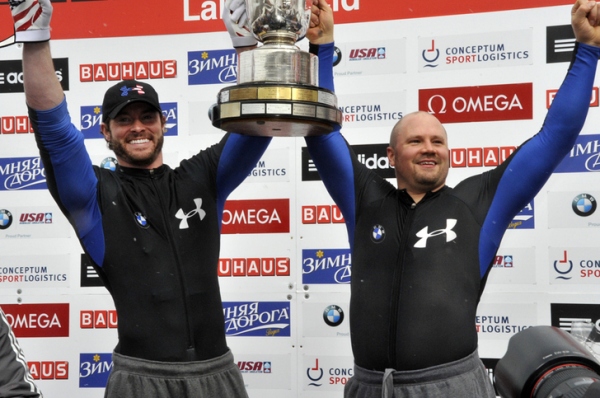Steve Holcomb: Driving to History
By Alan Abrahamson | 2/22/12 |
Three years ago, Steve Holcomb won gold at the bobsled world championships, driving a four-man sled.
Two years ago, he won four-man gold at the Olympic Games in Vancouver.
On Sunday, pushed by Steve Langton, Holcomb won gold in the two-man at the world championships in Lake Placid, N.Y.
It’s the first American gold in the two-man in the 80-year history of bobsled world championships.
That four-man worlds gold had been the first in 50 years; the Olympic four-man gold the first since 1948.
“I don’t know — I’m kind of running out of records to break,” Holcomb said late Sunday, laughing in disbelief.
“We had an unbelievable drive by Steve,” Langton said. “He is an unbelievable pilot. He can drive anything down the hill.”

Name another American in his sport who has achieved as much.
Michael Phelps has of course won more world championship and Olympic medals.
Shaun White has perhaps pushed more boundaries.
But in his sport, Steve Holcomb has lifted the United States team back to heights the Americans haven’t known since John Glenn was orbiting the earth all of three times. And before, way before — since the Great Depression.
In Olympic terms — before the first Los Angeles Summer Games in 1932.
Top that.
Later Sunday, Holcomb switched sleds and his brakeman, Justin Olsen, and anchored the U.S. to its first-ever worlds team gold by a margin of 56.20 seconds, the fastest of the eight teams competing — the times a combination of men’s and women’s skeleton, women’s bobsled and men’s two-man bobsled.
Germany had won all four prior team golds, in 2007, 2008, 2009 and 2011; the U.S. had taken silver in 2007, bronze in 2008 and 2009. Germany took second Sunday, 73-hundredths of a second back; Canada, third, 1.30 second behind.
Holcomb, in a telephone interview, repeatedly gave credit Sunday to his teammates, coaches and the U.S. support staff. He also said, “If you put a sled in front of me, I’m going to do my best to drive it.”
Holcomb turned not only his career but everything around in March, 2008, with the help of an eye doctor in Beverly Hills, Calif., Dr. Brian Boxer Wachler.
Holcomb was suffering from a condition called keratoconus, which causes the eye’s cornea to bulge outward. Glasses and contact lenses weren’t working. Lasik hadn’t worked, either. Holcomb was so nearsighted — and so frustrated — he was ready to quit bobsled.
How nearsighted? He couldn’t read the big E at the top of the charts. Not even close.
“It was kind of a standing joke,” Holcomb said Sunday, recalling what it had been like then. “I had to stand eight inches from the big E to see it.”
In 2003, it turned out, Boxer Wacher had developed a procedure to restore Holcomb’s vision. He called it C3-R; it involves administering drops to strengthen the cornea and then embedding a lens behind the iris of each eye. The procedure took remarkably little time.
Bingo.
The results on the track since speak for themselves. Simply put, when you have Holcomb’s innate talent, it makes an enormous difference to be able to see, actually see, where you’re going.
Boxer Wachler has since renamed the procedure the Holcomb C3-R.
Last September, at the U.S. Olympic Committee’s annual assembly in Colorado Springs, Colo., Holcomb — on stage to receive the 2010 team of the year award — became emotional when discussing the difference Boxer Wachler had made. He didn’t just save my career, Holcomb said. He saved my life.
Before Sunday, the best the United States had done in the two-man at the worlds was four silvers; the most recent had been in 1961. The Americans had won but six bronze medals; four had come between 1949 and 1967 and then Brian Shimer, now the U.S. men’s coach, had won one in 1997.
The way a competition like the two-man works at the worlds is, in all, four runs — the first two Saturday, the final two on Sunday.
Holcomb’s first run was off. He knew it. He posted to his Twitter feed, “Huge mistake in the first run. Sitting in 4th. Got it figured out. Time to make my move.”
In the second run, Langton powered to a 5.02-second start and Holcomb got them to the finish line fastest of the 27 sleds that finished the run — ending the day just 12-hundredths of a second behind Canada’s Lyndon Rush and Jesse Lumsden.
In Sunday’s first run — that is, the third overall – Langton again came out hot, at 5.07 and Holcomb got them down in 55.54 seconds, the fastest of any team in all four heats. That put the U.S. team up top by 20-hundredths of a second over the Canadians, 26-hundredths ahead of Germany’s Maximilian Arndt and Kevin Kuske.
“Very happy with my 1st run, but the race isn’t over,” Holcomb posted to Twitter. “Need to stay focused & relaxed, then do it again.”
Which is what he did, finishing the day with a final run of 55.63.
The U.S. team’s winning time over four runs: 3.42.88.
The Canadians finished 46-hundredths back, the Germans 55-hundredths.
All three U.S. sleds finished in the top 10: John Napier and Christopher Fogt took sixth, Nick Cunningham and Dallas Robinson ninth. Both Napier and Fogt are in the military and served overseas after the Vancouver Olympics, Napier six months in Afghanistan, Fogt a year in Iraq.
“Everything is clicking,” Holcomb said. “Everything is going well … Right now we are on top of the world. Everything is fantastic. I am living life. When you get a second chance at being able to see, it gives you a new perspective on life — it really does.”

COMMENTS